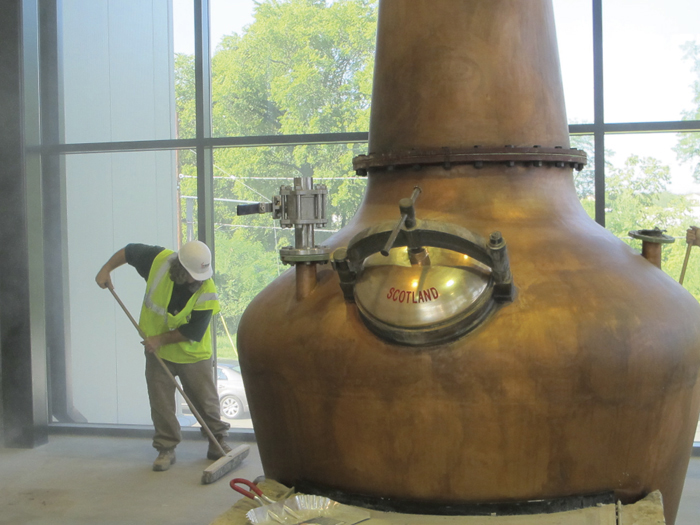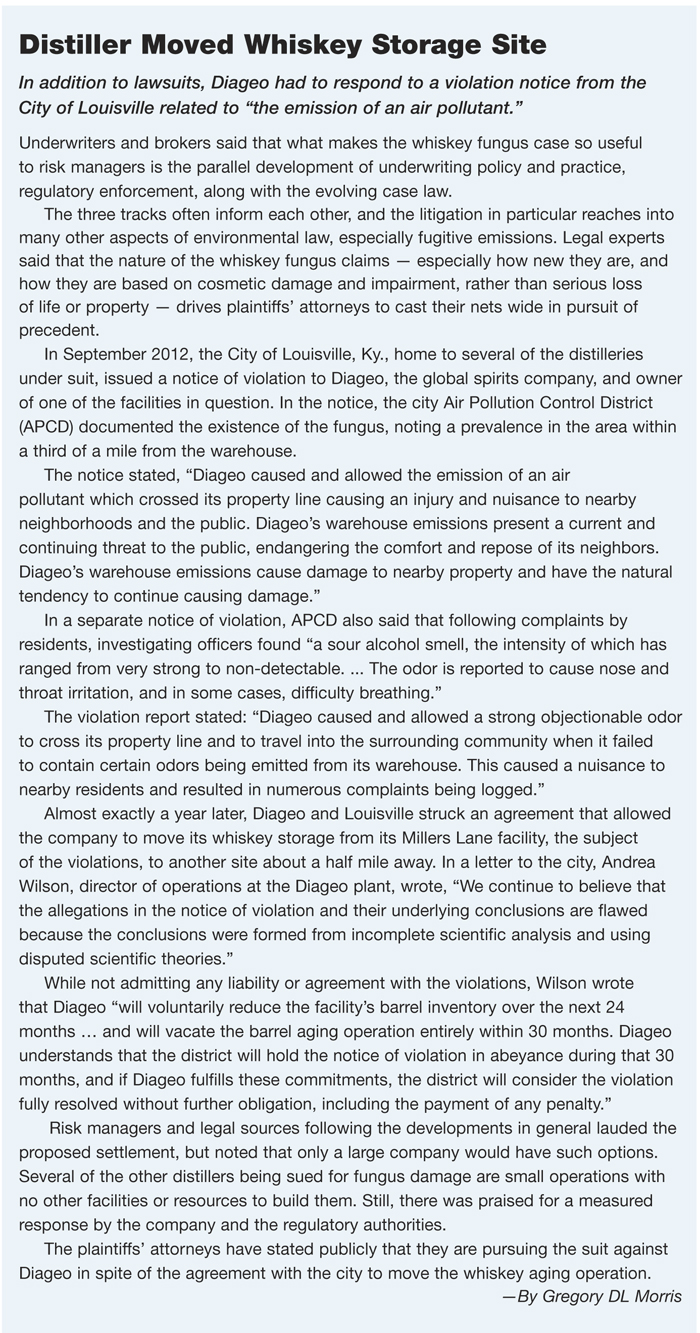Distilling Dilemma
The Devilish Details in the ‘Angels’ Share

As glasses clink with the warmth of whiskey this coming winter, class-action lawsuits are also heating up in the courts.
Plaintiffs have claimed that the making of whiskey is causing the growth of black gunk on structures near the distilleries. Attorneys and risk managers following the “whiskey fungus” cases agreed this will not evolve into the next asbestos or tobacco litigation, but the dispute is an instructive case in emerging environmental risk management.
When spirits are aged, roughly 2 percent of the ethanol escapes through the wood of the barrels. Since antiquity that has been known as “the angels’ share.” Whiskey fungus has also been known for centuries, and has been identified as Baudoinia compniacensis. It is not known to be hazardous to human health, as are other fungus and the mold infamous around New Orleans in the aftermath of Hurricane Katrina. It also is not known to be a threat to the structural integrity of buildings. Rather, it creates a gummy, sooty film on walls and vehicles. It can be scrubbed off with bleach or power washed, but it is tenacious.
The City of Louisville, Ky., published a report in 2012 tracing whiskey fungus complaints in the area to 2006. In June 2012, several homeowners in the city filed class-action suits against five regional distillers. There are several cases, but the lead case is now styled Merrick et al. vs. Diageo.
The plaintiffs allege that “as a result of the accumulation of whiskey fungus caused by defendants’ operations, plaintiffs and others similarly situated are required to expend an abnormal amount of time and money cleaning surfaces in and around their property, including gutters, siding, fencing and cars; [and that] whiskey fungus and the extreme cleaning methods necessary for its removal cause early weathering of surfaces affected by the fungus.”
At press time, the court was considering Diageo’s motion to dismiss the first amended complaint. In its motion, the company noted that its “allegedly tortious conduct, the emission of ethanol from whiskey aging or other facilities, falls directly within the class of activities regulated by the Clean Air Act, [and that] ethanol emissions are explicitly authorized by state operating permits issued under the CAA.” The defendants further asserted that the fungus is ambient in the environment and therefore not their responsibility.
“Is this an insurable risk, or is this the cost of doing business? If insurers see claims like this continuing, then it becomes likely this type of thing will be considered a normal part of the business and is likely to be excluded from policies.”
— Kenneth Cornell, executive vice president and chief underwriter for Aspen Environmental, part of Aspen Insurance Holdings
The issues being addressed are characteristic of a lot of emerging environmental risks, said Kenneth Cornell, executive vice president and chief underwriter for Aspen Environmental, part of Aspen Insurance Holdings. “So far, the claims, both insurance and legal, are for property damage. There is always the potential for bodily damage, though, because the science is not perfect.”
The insurance implications for the whiskey fungus depend largely on the outcome of the Kentucky cases, and to a lesser extent similar litigation taking place in Scotland. “Is this an insurable risk, or is this the cost of doing business?” Cornell asked. “If insurers see claims like this continuing, then it becomes likely this type of thing will be considered a normal part of the business and is likely to be excluded from policies.”
At that point, Cornell added, “you would get to some interesting risk management decisions. As the distillers have pointed out, they are operating in compliance with their air permits. The question is if they could — or whether they would want to — try to capture or manage ethanol emissions in some way. A lot turns on the class-action suits in Kentucky, but the risk-management part here needs to be studied further in any case.”
Specific to underwriting Cornell noted that the key question is to what extent the distillers have or can exert control over the ethanol emissions from their aging warehouses.
A Centuries-Old Dilemma
David Rieser, special counsel in the environment and regulatory practice at law firm Much Shelist, does not downplay the broader environmental implications of situations like that of the whiskey fungus, but also tries to keep this particular hazard in perspective. “This condition has been known for centuries. If there were a serious health problem, my sense is that it would be well known, too. For example, we have the term ‘mad as a hatter,’ from the use of mercury in treating pelts.”
The challenge with whiskey fungus does not appear to be its serious threat to people or property, but rather its ubiquity and that it tends to be a “chronic problem,” Rieser said. Those conditions also pose a challenge for attorneys and underwriters, he added. “Because of the ubiquity of the fungus in the environment, it is difficult to establish a cause-effect relationship.”
“Now with class-action litigation under way, carriers will be less likely or willing to cover such exposures.”
— Matt Pateidl, vice president of Environmental Risk, Lockton Cos.
Putting fungus and mold issues into perspective, Rieser said that “10 years ago in environmental law, many people were afraid mold would become the next asbestos. That has not really happened. There are health and property damage concerns, but not as serious in most cases as once was feared.”
The risk management lesson here, Rieser said, is that awareness of environmental hazards continues to evolve. “For distillers, their insurers, and their neighbors, the assumption has long been that the angels’ share just evaporates from the casks and that is the end of it. As with many environmental risks, now we are learning that may not be the end of it.”
At least the damage seems to be cosmetic and not structural, said Rieser. “Since the flurry of coverage last year, I have searched through the trade press and legal publications and as far as I have found, whiskey fungus does appear to be very limited in its impact, so far.”
He stressed “so far,” because one of the fast-growing segments of the spirits sector is craft distilling. Riding the coattails of the national renaissance in craft brewing, artisanal distillers are popping up all over. “I handle lots of permitting,” Rieser said. And while a major corporation might be able to handle litigation regarding whiskey fungus claims, such a burden would be heavy on a small operation, he said.
In any case, Rieser urged distillers to be vigilant. “I certainly would not be out knocking on doors, you don’t want to put ideas in anyone’s head. But, be aware. Look around your area for evidence of the fungus.” He also urged anyone in the field to keep current on the litigation and to stay abreast of coverage in the trade press.
Historical Context
There could be other exposures as well, said Matt Pateidl, vice president of environmental risk at Lockton Cos. “We have seen instances of mold in areas around bakeries, but not around breweries. So far, the links to this type of surface growth is around spirits and baking.”
Taking the historic context back an order of magnitude Pateidl cited a biblical reference (Leviticus 14:43-53) as the first historical reference for a mold remediation plan. He sees a similar pattern in the insurance and legal developments around whiskey fungus as was seen in mold exposures. “At first there was a thought that mold was gold,” said Pateidl. “We started seeing mold exclusions in general liability coverage. Now that whiskey fungus is spawning lawsuits, we may see the same type of exclusions being added.”
Pateidl said the essential question is whether the whiskey fungus is an insurable condition, either for distillers or for their neighbors. But the time may have passed for that contemplation. “Now with class-action litigation under way, carriers will be less likely or willing to cover such exposures.”
He likened the situation to the debates and litigation over odors from feedlots or “confined animal feeding facilities.” There were insurance claims and lawsuits turning on the point of “diminution of value.”
Pateidl also offered a cautionary note: “The insurance industry mostly saw the odor claims as nuisance claims, but there were several multi-million-dollar rulings.”
Bringing the discussions back around to the key point in the Kentucky class action, Pateidl stressed that there have been no claims that the distillers violated their air permits.
If the litigation continues or even grows, there is always the chance that legislators or regulators may look into fugitive emissions in future permit rules.
“For insureds and their carriers, the first question is whether these emissions can be captured or prevented from migrating,” said Pateidl.
“With class actions under way, carriers are going to be very cautious about issuing policies to cover this situation. They will look at coverage case by case and client by client,” he said. “I’m not saying it would not be covered, but it will be heavily underwritten and closely scrutinized.”











